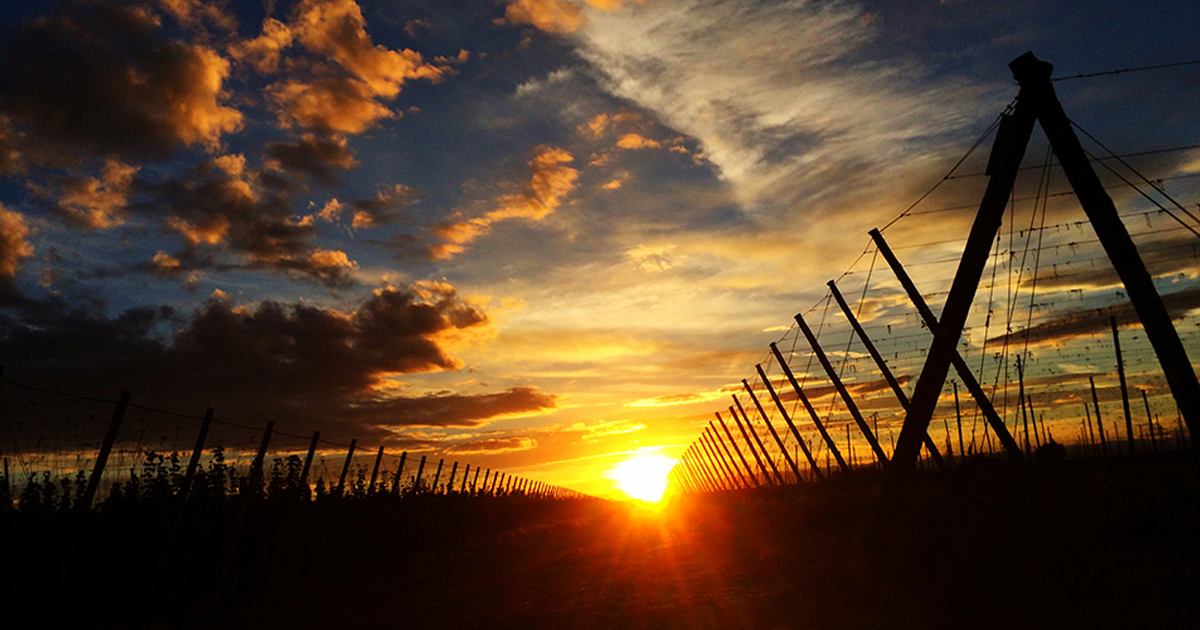Top Beer Hops and Hop Growing Trends
At Hopsteiner, we take great pride in the community and culture that our business creates. We are happy to bring people together and expand the beers poured around the world – all with high-quality beer hops, sustainable hop growing practices, and a great team to make it all happen.
Here’s What’s Hoppin’ This Season in Hop Growing Conditions
Our hop crops are affected by a number of weather and environmental conditions, which vary between hop growing seasons and years. Our farmers pay close attention to these conditions, along with the health of each hop plant.
Washington Growing Conditions
Powdery mildew and downy mildew have both increased in certain regions this growing season. Downy mildew is one of the most prominent diseases in hop growing and is caused by Pseudoperonospora humuli. If not caught in time and treated, the yield and quality of the hop ones affected can deteriorate. One of the symptoms of this is the presence of infected shoots, which will show in the curling or brittle appearance of the leaves. Powdery mildew is one of the most deadly and widespread diseases of hop growing worldwide. You will see developments of white powder-like colonies on either side of the leaves or the other plant parts.
Temperatures have been fluctuating this growing season, leaving baby yards off to a weak start. All hop plants love the sun, which is why Yakima is such a great place to grow hops. First year hop plants require much desert-like conditions. The late spring mixed with cooler temperatures has not been beneficial for newly planted crops this seasons, but temperatures are expected to climb.
Oregon Growing Conditions
Flood water has been the biggest issue for small fields this season in Oregon, which could result in a 50-to-100 percent loss of some crops in certain areas. Aside from some of the wetter-than-normal conditions, yield is strong. Farmers are treating the area for aphids, which are small insects that can deteriorate the quality of the hop and in extreme instances kill the plant altogether if left unattended to. Powdery mildew and downy mildew are minimal, but farmers are always on the lookout for this in the Oregon region because it can have a deadly impact on yield as well.
Precipitation recovered from its lower-than-normal levels this past season and is approaching the historical average. Temperatures are expected to have a rapid increase in the coming weeks, estimating between 80 and 90 degrees.
Idaho Growing Conditions
Growth in mature yards is sporadic in some cases but is expected to even out.
Powdery mildew and downy mildew are present, but farmers are following a strict treatment program to minimize the hop crop damage. The first half of May was dry, but the following few weeks were followed with four inches of rainfall. Temperatures are expected to increase in the coming weeks.
Beers and Hopsteiner Hops
Beer hops come in different sizes and shapes, flavors and tastes. You can mix and match them or let them stand alone to be the star of your next pour. Many new aroma and dual hop varieties are constantly being introduced to our diverse portfolio of offerings.
Mixing and Matching
Our customers love to blend hops for creating new and unique flavors to serve. Campden BRI conducted a study that successfully developed three new blend models which have unique flavors to match current beer trends.
We are always researching different hop blends and working at new variety developments. Our hop breeding program has released several unique varieties, such as (link to VDS) Apollo™, Calypso™, Bravo™, Eureka! ™, Delta™, Lemondrop™, and Lotus™. Through years of research and cross-breeding with the use of molecular marker-assisted technology, we have developed and perfected the most viable and agronomically sound beer hops. All of our proprietary varieties are bred to withstand the tests of time – giving way to higher yields, superior aroma, and better agronomical sustainability to ensure future prosperity.
Hopsteiner’s Top Hops
Each season, we find our latest hops selling out, with current hop varieties becoming our customers’ new favorites. Here is a quick snapshot of some of the favorite types of hops among our customers:
Lemondrop™ Hops
Our Lemondrop™ hops offer aromas of lemon, mint, green tea, and light melon. These hops provide a “unique lemon-citrus character with a pleasant aroma.” If you are in between a lager and ale drinker, Lemondrop™ is delicate yet refined in taste.
Calypso Hops™
The Calypso™ hops have a fruity, apple, pear, and herbal aroma. Calypso™ is commonly used to dry-hop beer because of its unique tropical fruit and sweet apple-pear aromas.
Lotus™ Hops
Lotus™ hops have a tropical fruit, berry, orange, vanilla aroma. Lotus™ is commonly used to bring out orange, vanilla, and tropical flavors with a nice hint of bitterness.
Trends in Beer Production, Craft Beer Experience, and More
Public vs. Proprietary Acreage Trends
The year 2019 has shown an almost 9 percent decrease in public acreage and a 19 percent increase in proprietary acreage in a year-over-year comparison with 2018. The total pounds of hops produced continues to rise, estimating an upwards of 110,000 pounds to be harvested in 2019.
Growth in Craft Beer
The volume of craft beer in the U.S. was 30.3 million hectoliters at the end of 2018, which was a 4 percent increase from 2017. This growth is expected to increase into the remainder of 2019.
In addition to the growth of craft beer production, the number of breweries around the country continues to increase. In 2018, there were over 7,000 breweries, and this number continues to rise into 2019.
We’re seeing a trend of microbreweries as an extension of the growing interest in craft beer and brewery experiences. In 2018, 589 new microbreweries opened, adding to what we in the industry are calling the Craft Beer Boom. Microbreweries have been favored over others, largely because of their local appeal
What do we know from this? People love beer, breweries, and microbreweries at an increasing rate. Cheers to that!
Helping Our Environment, One Pour at a Time
Hopsteiner is Global G.A.P. certified and works directly with hop growers in principal growing areas. This includes four hop ranches of our own in the USA for growing, breeding, and processing hops. We regularly invest in hop growing and harvesting equipment and technology. Some of our new sustainable ventures are in the areas of hop which combine harvesting, drip irrigation, crop improvement, and hop breeding.
Much of our focus on technology investment comes from our long-term sustainability goals. We emphasize efficiency, and have developed systems with the preservation of Earth’s natural resources in mind. Hopsteiner has been at the forefront of sustainable practices for many years and is continuously seeking alternative renewable resources.
What’s New at Hopsteiner
We are always working on something new at Hopsteiner – for our customers, our employees, and for the very grounds we grow hops on. Our additions include a new extract processes, VFS packaging, smaller packaging, new labor housing, and a new hop conditioning warehouse.
Product Development is Our Passion.
We are constantly cooking up new hop products. Our latest is a flowable hop extract called HopFlow. HopFlow is typically used in the boil as a partial replacement to whole cone or pellet hops, lending to better overall consistency and efficiency in the brew-house. Check out our hop leaves, hop pellets, C02 extracts, hop extracts, and oils for a new addition to your next brew.
New to Beer Hops?
If you are new to buying hops or using hops, here is a beginner’s guide:
Beer hops are used as the bittering counterpoint to sweet malt. Hops are responsible for giving beers their unique flavors and aromas.
Anyone and everyone can use beer hops. You don’t have to own a brewery to make your own beer. As a matter of fact, home brewers are on the rise. Many people are interested in making their own perfect blends, and they are using our diverse portfolio of beer hops to do it.
We provide a number of resources for brewers of all sizes, including an IBU calculator, which measures the bitterness of a beer. We also have an ABV calculator, which can tell you how much alcohol is in a certain volume of your beer. You can visit our various hops Tools on our website and learn about ways you can classify your beer, measure its alcohol content, and define its bitterness.
Our products and hop varieties can be conveniently sourced from anywhere within the continental US by using our online Portal. Simply create an account at Hopsteiner.com to browse, shop, and manage your hop purchases from our global inventory.
The Proof is in the Pour
Hopsteiner is a vertically integrated global hops supplier dedicated to delivering the finest hops and hop products available. For six-generations, Hopsteiner has partnered with breweries of all sizes, offering unique hop varieties and innovative hop products designed to enhance flavor, aroma, consistency, and flexibility for brewing and beyond. Learn more at Hopsteiner.com.

